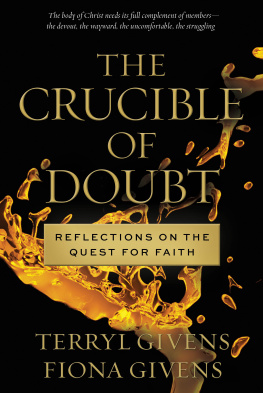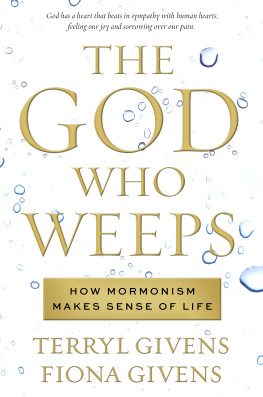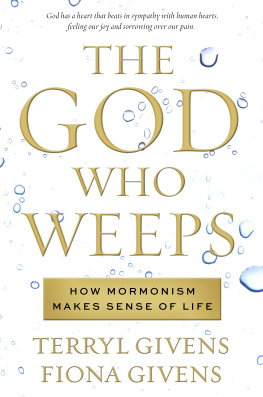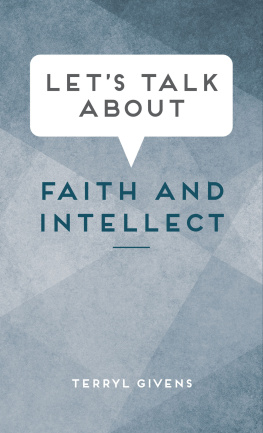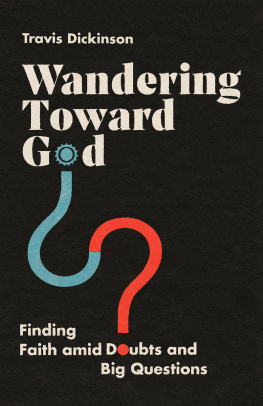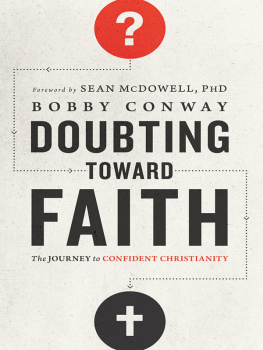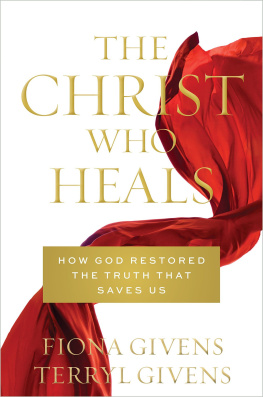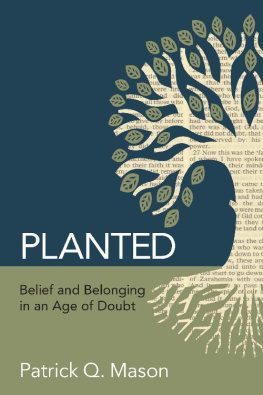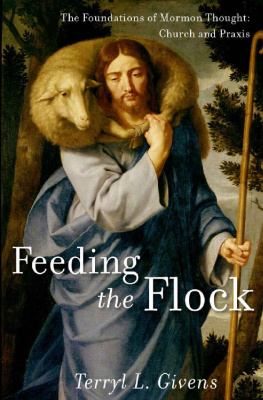Crucible of Doubt
Reflections on the Quest for Faith
Terryl Givens, Fiona Givens
2014 Terryl L. Givens.
All rights reserved. No part of this book may be reproduced in any form or by any means without permission in writing from the publisher, Deseret Book Company (permissions@deseretbook.com), P.O. Box 30178, Salt Lake City Utah 84130. This work is not an official publication of The Church of Jesus Christ of Latter-day Saints. The views expressed herein are the responsibility of the author and do not necessarily represent the position of the Church or of Deseret Book. Deseret Book is a registered trademark of Deseret Book Company.
Deseret Book is a registered trademark of Deseret Book Company.
Visit us at DeseretBook.com
Library of Congress Cataloging-in-Publication Data
Givens, Terryl, author.
The crucible of doubt : reflections on the quest for faith / Terryl Givens, Fiona Givens.
pages cm
Includes bibliographical references and index.
ISBN 978-1-60907-942-0 (hardbound : alk. paper)
1. Faith. 2. Church of Jesus Christ of Latter-day SaintsDoctrines. 3. Mormon ChurchDoctrines. I. Givens, Fiona, author. II. Title.
BX8635.3.G57 2014
234'.23dc232014019187
Printed in the United States of America Publishers Printing, Salt Lake City, UT
10 9 8 7 6 5 4 3 2 1
To Zina and Boyd
Disciples of the God who laughs
It is not like a child that I believe in Christ and profess faith in Him, but rather, my hosanna has come through the great crucible of doubt.
Fyodor Dostoevsky

Crucible, n. [LL. crucubulum, a hanging lamp, an earthen pot for melting metals]
A vessel used for melting or refining substances which require a strong degree of heat, as metals, ores, etc.

Notes
Fyodor Dostoevsky, The Unpublished Dostoevsky: Diaries and Notebooks (Ann Arbor: Ardis, 1976), 175.
Introduction
Paradigms and Premises:
Starting Off on the Wrong Foot

In the area known as the Netherbow, located along the Royal Mile in Edinburgh, Scotland, there is a magnificent restored house, built shortly before Columbus sailed for the New World. It is called the John Knox house, but that great reformer lived in it only briefly, if at all. The house was actually occupied in the sixteenth century by James Mossman, goldsmith to Mary, Queen of Scots. Mossman was, as one might expect, a man of great wealth. He was also a brilliant craftsman and artificer. On the third floor of his substantial home is a room protected by a heavy oak door. Off center, on the right of a large iron panel that conceals the locking mechanism, is a keyhole.

It does not appear to be a lock that would be more resistant than most to tampering or picking, but it is. No burglar, no matter how ingenious, ever did or ever could gain access to the room by manipulating the mechanism accessed through this keyhole. No skeleton keyno, not even the master key itselfwill turn the heavy tumblers and open the lock that guards the room. At least, not via this keyhole.
For the keyhole is a dummy keyhole. The ornamental bar next to it conceals the real keyhole and the location of the true lock.
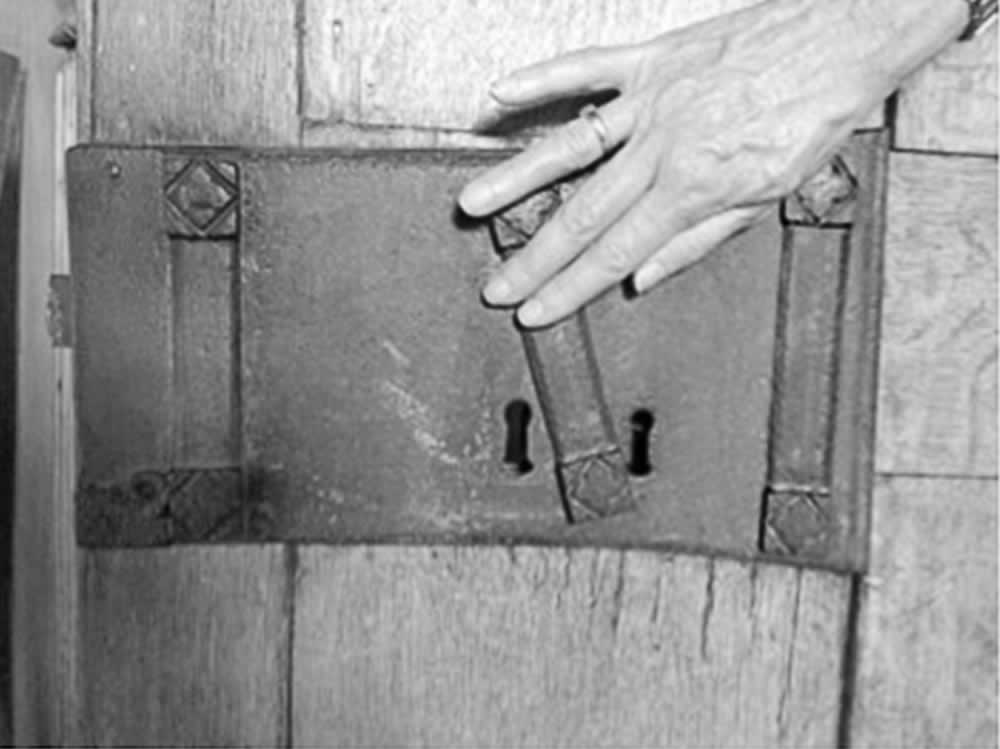
It is impossible to know how many would-be thieves dulled their picks and rubbed their fingers raw in a fruitless effort to gain access to the riches on the far side of Mossmans door. Their assumption would have been reasonable enough: Here is the door, here is the keyhole, this is the way to the treasure. But their assumption would have been wrong.
We all inhabit geographical, linguistic, and social worlds that shape our vision and our impressions of what is normal, what is real. Our worldview is a collective set of assumptions we carry with us that condition every question we ask. These paradigms make it possible to guide inquiry, but they can also limit and impede our inquiry. They can get us off on the wrong foot, obscure our line of sight, or simply misdirect our focus. This is because, all too often, we dont realize the limiting assumptions with which we are working.
We cant easily step outside most such preconceptions. Even recognizing the extent of our unexamined assumptions can be the hardest thing of all. It is like asking a fish what it is like to be wet. What is wet? even a miraculously verbal fish would reply. Our assumptions, like the ocean in which a fish swims, are the invisible background to our thinking, waking existence. Only when we have left a misguided assumption behind are we able to see it clearly. Then we no longer ask why ships do not fall off the edge of the world. We dont bind women we dont like, throw them into a pond, and watch to see if they float or sink. Neither do scientists try to measure the earths motion relative to the space through which it speeds. Flat earths, witchcraft, and the cosmic ether are no longer part of our intellectual universe. We now see them for the erroneous frameworks they were. They have gone the way of alchemy and philosophers stones. It should not be that difficult to recognize the implications of these transformations for our present circumstances and lives; we are inevitably living under the burden of some paradigms, individually and collectively, that will one day be relics with other conceptual assumptions we have cast off. It is only with hindsight that we can see the paradigms of the past for the intellectual straitjackets they were.
The important point, however, is that those frameworks are not just themselves error-laden. Erroneous assumptions do not just forestall truth and progress, although that would be cause enough to lament their malign influence in our lives. They are like the dummy lock of Mossmans home. They point us in the wrong direction, limit our understanding, and even warp the questions we ask. Worse, they create the conditions for faulty reasoning and disastrous conclusions. In past ages, bad paradigms led well-intentioned physicians to bleed to the brink of death and beyond millions of the already sick and enfeebled. No scientist had reason to seek for the sources of disease in filth, fleas, or dirty water in a world where the four humors were believed to govern all physical and emotional health.
In the realm of religion and spirituality, as in the areas of science, medicine, and public order, wrong assumptions can provide invisible deterrents to a life of religious devotion. Such flawed paradigms have been known to trouble even stalwarts of the faith. Great Christian thinkers of the past have operated with assumptionssome of them deeply ingrained, sanctioned by long tradition, by ecclesiastical authority, and by scripturethat made answers difficult or impossible to obtain. At the least, such assumptions can delay prayerful responses to earnest questions, even by decades.

